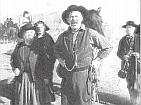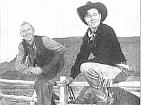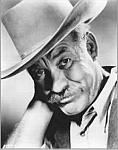
WAGON MASTER |




RKO, 1950, 86 mins. 35mm print source: Warner Bros. Classics.
Directed by John Ford. Written by Frank S. Nugent and Patrick Ford. Produced by Ford
and Merian C. Cooper. Photographed by Bert Glennon. Edited by Jack Murray. Art direction
by James Basevi.
With Ben Johnson (as Travis Blue), Harry Carey, Jr. (Sandy Owens), Ward Bond (Elder
Wiggs), Joanne Dru (Denver), Charles Kemper (Uncle Shiloh Clegg), Alan Mowbray (Dr. A.
Locksley Hall), Jane Darwell (Sister Ledeyard), and Ruth Clifford (Fleuretty Phyffe).
From John Ford: The Man and His Films by Tag Gallagher (University of California,
1986):
That Wagon Master, one of Ford’s masterpieces, grossed about a third of
any of the cavalry pictures surely came as no surprise. It was a personal project, with no
stars, little story, deflated drama, almost nothing to attract box office or trendy
critics. The story, resembling the Carey-Fords of the teens more than a fifties western,
was written by Ford himself, the only such instance after 1930, and he was ruthless with
the script. Said Frank Nugent: "We did not work at all closely. . . . His script
cutting—especially of dialogue—was rather harsh." Of all his pictures, said
Ford, "Wagon Master came closest to what I had hoped to achieve. It is the
purest and simplest western I have made."
The magic that places Wagon Master among Ford’s most enduringly rewarding
movies tends, alas, to elude many viewers, particularly upon first viewing and
particularly because purity and simplicity define that magic, for such qualities are far
from those usually associated in the public mind with Great Motion Pictures. But Wagon
Master is more poetry than drama, weaving together the West’s purest myths with
the simplest, most natural characters. . . .
It almost seems as though Ford tried to promote Ward Bond, Ben Johnson, Harry Carey, Jr.,
and Joanne Dru; he listed their parts next to their names in the opening credits—the
only time he was ever to do so. And each of them gets plenty of evocative cameo shots,
with the three men frequently lined up in front of the camera to trade remarks and
gesticulate. But normal Hollywood star-creation employs quite different techniques: high
energy performances rather than laid-back ones, and subjective rather than distancing
camera techniques. For example, in an Errol Flynn film, in contrast to Ford, we see
everything from Flynn’s point of view; we are encouraged toward empathetic
"identification" with him. But in Wagon Master folks just
"be." And we watch. For as always in Ford, symbols, apotheoses, and poetry are
counterbalanced by the relaxed "realism" of individuals, although nowhere else
to this degree of simplicity, purity, and naturalness. Here above all is where Wagon
Master’s magic resides. Watching Ward Bond whittle becomes wonderful, and the
moment on the fence when Travis and Sandy sing to each other becomes one of the miracles
in Ford. As in Steamboat Round the Bend and How Green Was My Valley it is Wagon
Master’s thesis that each little happening is grace....
More, perhaps, than any other film, Wagon Master is less interested in where it is
going (plot), than in where it is (the moment). Still, obviously, it is a movie about passage—a
"parade" West. Only briefly is "home," the antinomy of passage,
suggested. And immediately upon its suggestion, it is abruptly refused by the film, which
obstinately cuts back into flashbacks, back to passage rather than fulfillment, back to
the past, to distance. And the movie fades out during a pan as a young colt steps up onto
firm ground after fording a river—an image of eager progeny that sums up Wagon
Master in the forward motion of life.

 Back To Bond
Back To Bond

 West Links
West Links
2/27/01 6:11:12 AM